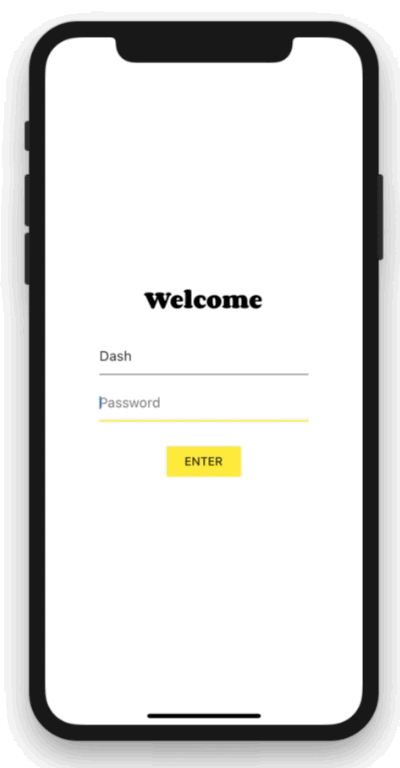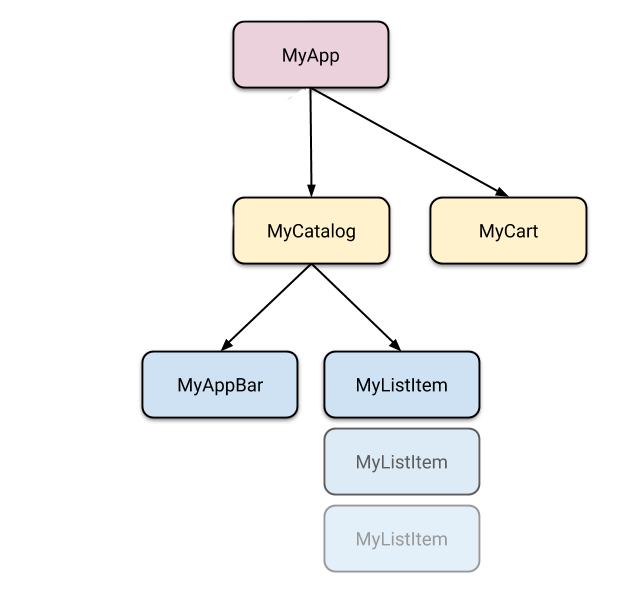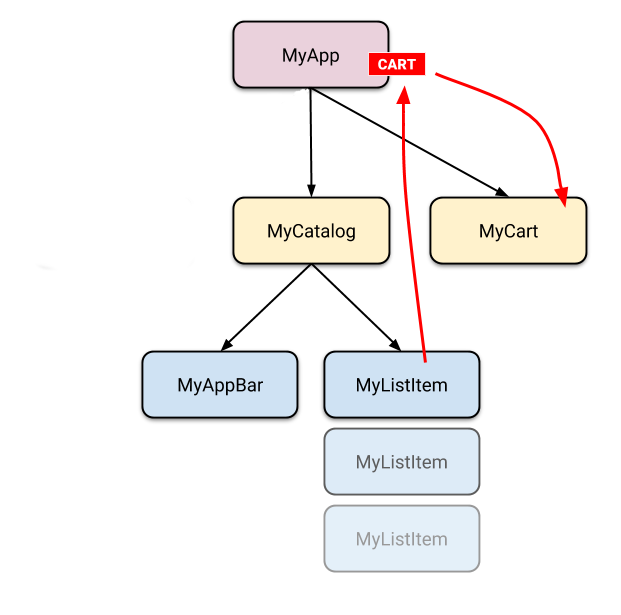Simple app state management
A simple form of state management.
Now that you know about declarative UI programming and the difference between ephemeral and app state, you are ready to learn about simple app state management.
On this page, we are going to be using the provider package.
If you are new to Flutter and you don't have a strong reason to choose
another approach (Redux, Rx, hooks, etc.), this is probably the approach
you should start with. The provider package is easy to understand
and it doesn't use much code.
It also uses concepts that are applicable in every other approach.
That said, if you have a strong background in state management from other reactive frameworks, you can find packages and tutorials listed on the options page.
Our example
#
For illustration, consider the following simple app.
The app has two separate screens: a catalog,
and a cart (represented by the MyCatalog,
and MyCart widgets, respectively). It could be a shopping app,
but you can imagine the same structure in a simple social networking
app (replace catalog for "wall" and cart for "favorites").
The catalog screen includes a custom app bar (MyAppBar)
and a scrolling view of many list items (MyListItems).
Here's the app visualized as a widget tree.

So we have at least 5 subclasses of Widget. Many of them need
access to state that "belongs" elsewhere. For example, each
MyListItem needs to be able to add itself to the cart.
It might also want to see whether the currently displayed item
is already in the cart.
This takes us to our first question: where should we put the current state of the cart?
Lifting state up
#In Flutter, it makes sense to keep the state above the widgets that use it.
Why? In declarative frameworks like Flutter, if you want to change the UI,
you have to rebuild it. There is no easy way to have
MyCart.updateWith(somethingNew). In other words, it's hard to
imperatively change a widget from outside, by calling a method on it.
And even if you could make this work, you would be fighting the
framework instead of letting it help you.
// BAD: DO NOT DO THIS
void myTapHandler() {
var cartWidget = somehowGetMyCartWidget();
cartWidget.updateWith(item);
}
Even if you get the above code to work,
you would then have to deal
with the following in the MyCart widget:
// BAD: DO NOT DO THIS
Widget build(BuildContext context) {
return SomeWidget(
// The initial state of the cart.
);
}
void updateWith(Item item) {
// Somehow you need to change the UI from here.
}
You would need to take into consideration the current state of the UI and apply the new data to it. It's hard to avoid bugs this way.
In Flutter, you construct a new widget every time its contents change.
Instead of MyCart.updateWith(somethingNew) (a method call)
you use MyCart(contents) (a constructor). Because you can only
construct new widgets in the build methods of their parents,
if you want to change contents, it needs to live in MyCart's
parent or above.
// GOOD
void myTapHandler(BuildContext context) {
var cartModel = somehowGetMyCartModel(context);
cartModel.add(item);
}
Now MyCart has only one code path for building any version of the UI.
// GOOD
Widget build(BuildContext context) {
var cartModel = somehowGetMyCartModel(context);
return SomeWidget(
// Just construct the UI once, using the current state of the cart.
// ···
);
}
In our example, contents needs to live in MyApp. Whenever it changes,
it rebuilds MyCart from above (more on that later). Because of this,
MyCart doesn't need to worry about lifecycle—it just declares
what to show for any given contents. When that changes, the old
MyCart widget disappears and is completely replaced by the new one.

This is what we mean when we say that widgets are immutable. They don't change—they get replaced.
Now that we know where to put the state of the cart, let's see how to access it.
Accessing the state
#
When a user clicks on one of the items in the catalog,
it's added to the cart. But since the cart lives above MyListItem,
how do we do that?
A simple option is to provide a callback that MyListItem can call
when it is clicked. Dart's functions are first class objects,
so you can pass them around any way you want. So, inside
MyCatalog you can define the following:
@override
Widget build(BuildContext context) {
return SomeWidget(
// Construct the widget, passing it a reference to the method above.
MyListItem(myTapCallback),
);
}
void myTapCallback(Item item) {
print('user tapped on $item');
}
This works okay, but for an app state that you need to modify from many different places, you'd have to pass around a lot of callbacks—which gets old pretty quickly.
Fortunately, Flutter has mechanisms for widgets to provide data and
services to their descendants (in other words, not just their children,
but any widgets below them). As you would expect from Flutter,
where Everything is a Widget™, these mechanisms are just special
kinds of widgets—InheritedWidget, InheritedNotifier,
InheritedModel, and more. We won't be covering those here,
because they are a bit low-level for what we're trying to do.
Instead, we are going to use a package that works with the low-level
widgets but is simple to use. It's called provider.
Before working with provider,
don't forget to add the dependency on it to your pubspec.yaml.
To add the provider package as a dependency, run flutter pub add:
flutter pub add provider
Now you can import 'package:provider/provider.dart';
and start building.
With provider, you don't need to worry about callbacks or
InheritedWidgets. But you do need to understand 3 concepts:
- ChangeNotifier
- ChangeNotifierProvider
- Consumer
ChangeNotifier
#
ChangeNotifier is a simple class included in the Flutter SDK which provides
change notification to its listeners. In other words, if something is
a ChangeNotifier, you can subscribe to its changes. (It is a form of
Observable, for those familiar with the term.)
In provider, ChangeNotifier is one way to encapsulate your application
state. For very simple apps, you get by with a single ChangeNotifier.
In complex ones, you'll have several models, and therefore several
ChangeNotifiers. (You don't need to use ChangeNotifier with
provider
at all, but it's an easy class to work with.)
In our shopping app example, we want to manage the state of the cart in a
ChangeNotifier. We create a new class that extends it, like so:
class CartModel extends ChangeNotifier {
/// Internal, private state of the cart.
final List<Item> _items = [];
/// An unmodifiable view of the items in the cart.
UnmodifiableListView<Item> get items => UnmodifiableListView(_items);
/// The current total price of all items (assuming all items cost $42).
int get totalPrice => _items.length * 42;
/// Adds [item] to cart. This and [removeAll] are the only ways to modify the
/// cart from the outside.
void add(Item item) {
_items.add(item);
// This call tells the widgets that are listening to this model to rebuild.
notifyListeners();
}
/// Removes all items from the cart.
void removeAll() {
_items.clear();
// This call tells the widgets that are listening to this model to rebuild.
notifyListeners();
}
}
The only code that is specific to ChangeNotifier is the call
to notifyListeners(). Call this method any time the model changes in a way
that might change your app's UI. Everything else in CartModel is the
model itself and its business logic.
ChangeNotifier is part of flutter:foundation and doesn't depend on
any higher-level classes in Flutter. It's easily testable (you don't even need
to use widget testing for it). For example,
here's a simple unit test of CartModel:
test('adding item increases total cost', () {
final cart = CartModel();
final startingPrice = cart.totalPrice;
var i = 0;
cart.addListener(() {
expect(cart.totalPrice, greaterThan(startingPrice));
i++;
});
cart.add(Item('Dash'));
expect(i, 1);
});
ChangeNotifierProvider
#
ChangeNotifierProvider is the widget that provides an instance of
a ChangeNotifier to its descendants. It comes from the provider
package.
We already know where to put ChangeNotifierProvider: above the widgets that
need to access it. In the case of CartModel, that means somewhere
above both MyCart and MyCatalog.
You don't want to place ChangeNotifierProvider higher than necessary
(because you don't want to pollute the scope). But in our case,
the only widget that is on top of both MyCart and MyCatalog
is MyApp.
void main() {
runApp(
ChangeNotifierProvider(
create: (context) => CartModel(),
child: const MyApp(),
),
);
}
Note that we're defining a builder that creates a new instance
of CartModel. ChangeNotifierProvider is smart enough not
to rebuild
CartModel unless absolutely necessary. It also automatically calls
dispose() on CartModel when the instance is no longer needed.
If you want to provide more than one class, you can use MultiProvider:
void main() {
runApp(
MultiProvider(
providers: [
ChangeNotifierProvider(create: (context) => CartModel()),
Provider(create: (context) => SomeOtherClass()),
],
child: const MyApp(),
),
);
}
Consumer
#
Now that CartModel is provided to widgets in our app through the
ChangeNotifierProvider declaration at the top, we can start using it.
This is done through the Consumer widget.
return Consumer<CartModel>(
builder: (context, cart, child) {
return Text('Total price: ${cart.totalPrice}');
},
);
We must specify the type of the model that we want to access.
In this case, we want CartModel, so we write
Consumer<CartModel>. If you don't specify the generic (<CartModel>),
the provider package won't be able to help you. provider
is based on types,
and without the type, it doesn't know what you want.
The only required argument of the Consumer widget
is the builder. Builder is a function that is called whenever the
ChangeNotifier changes. (In other words, when you call notifyListeners()
in your model, all the builder methods of all the corresponding
Consumer widgets are called.)
The builder is called with three arguments. The first one is context,
which you also get in every build method.
The second argument of the builder function is the instance of
the ChangeNotifier. It's what we were asking for in the first place.
You can use the data in the model to define what the UI should look like
at any given point.
The third argument is child, which is there for optimization.
If you have a large widget subtree under your Consumer
that doesn't change when the model changes, you can construct it
once and get it through the builder.
return Consumer<CartModel>(
builder: (context, cart, child) => Stack(
children: [
// Use SomeExpensiveWidget here, without rebuilding every time.
?child,
Text('Total price: ${cart.totalPrice}'),
],
),
// Build the expensive widget here.
child: const SomeExpensiveWidget(),
);
It is best practice to put your Consumer widgets as deep in the tree
as possible. You don't want to rebuild large portions of the UI
just because some detail somewhere changed.
// DON'T DO THIS
return Consumer<CartModel>(
builder: (context, cart, child) {
return HumongousWidget(
// ...
child: AnotherMonstrousWidget(
// ...
child: Text('Total price: ${cart.totalPrice}'),
),
);
},
);
Instead:
// DO THIS
return HumongousWidget(
// ...
child: AnotherMonstrousWidget(
// ...
child: Consumer<CartModel>(
builder: (context, cart, child) {
return Text('Total price: ${cart.totalPrice}');
},
),
),
);
Provider.of
#
Sometimes, you don't really need the data in the model to change the
UI but you still need to access it. For example, a ClearCart
button wants to allow the user to remove everything from the cart.
It doesn't need to display the contents of the cart,
it just needs to call the clear() method.
We could use Consumer<CartModel> for this,
but that would be wasteful. We'd be asking the framework to
rebuild a widget that doesn't need to be rebuilt.
For this use case, we can use Provider.of,
with the listen parameter set to false.
Provider.of<CartModel>(context, listen: false).removeAll();
Using the above line in a build method won't cause this widget to
rebuild when notifyListeners is called.
Putting it all together
#
You can check out the example
covered in this article.
If you want something simpler,
see what the simple Counter app looks like when
built with provider.
By following along with these articles, you've greatly
improved your ability to create state-based applications.
Try building an application with provider yourself to
master these skills.
Unless stated otherwise, the documentation on this site reflects Flutter 3.38.1. Page last updated on 2025-10-30. View source or report an issue.